ENVIRONMENT
DISCLOSURES ALIGNED WITH THE TNFD RECOMMENDATIONS
As an organization that uses forest resources, we are committed to understanding biodiversity and raw material risks and to ascertaining environmental risks pertaining to our business sites and the surrounding areas. As part of this, we keep track of developments related to the Taskforce on Nature-related Financial Disclosures (TNFD) and follow the TNFD recommendations. That is, for nature-related matters, we develop organizational processes, evaluate and act on priority issues, and improve the quality of disclosures.
Governance
The KOKUYO group regards contributing toward a society that coexists with nature as a key element of sustainability. As with other important aspects of sustainability, we take a holistic approach to managing issues relating to biodiversity and the natural environment within our organizational infrastructure for sustainability.
We have an organizational framework for facilitating nature-positive actions such as preserving or restoring biodiversity. Specifically, under the supervision of the Board of Directors, the Sustainability Committee identifies nature-related risks so that the management can incorporate the information into strategic planning and take the decisions and actions necessary to mitigate the risks. The Sustainability Committee manages and monitors biodiversity and other important sustainability matters in an integrated manner. To supervise this process effectively, the Board of Directors hears reports from the committee twice a year and then deliberates on nature-related risks and other sustainability issues. The board also makes decisions on any sustainability matter that is strategically significant.
The Sustainability Committee’s membership consists entirely of managing officers and it is chaired by the Managing Officer of the CSV Division. The Committee monitors social and environmental trends to identify strategic concerns related to sustainability. It then formulates action plans and allocates budgetary resources for addressing these concerns. Regarding biodiversity, our Environment Subcommittee (a subcommittee of our Sustainability Committee) collaborates with the managers responsible for each business division to identify risks, incorporate the findings into strategic planning, and spearhead organization-wide efforts to solve issues.
When it comes to supply chain management, we have established the KOKUYO Group Sustainable Procurement Policy and Guidelines to clarify internal controls and build trust with suppliers. The Sustainability Committee monitors supply chain engagement to check whether it aligns with the policy and guidelines, contributing to effective supervision of risks and opportunities across the supply chain. Since timber resources are particularly important to KOKUYO Group, we also established, separately from these policy and guidelines, the KOKUYO Group Policy on Timber Procurement and KOKUYO Group Standards for Paper and Timber Procurement to help keep timber procurement is legal, transparent, and sustainable, ensuring harmony between business growth and forests.
Strategies
The LEAP approach designed by the Taskforce on Nature-related Financial Disclosures (TNFD) enables us to identify our dependencies and impacts on nature and our nature-related risks and opportunities, and informs our deliberations on measures to reduce our environmental footprint and to address these risks and opportunities.
In implementing the LEAP approach, we determine the business assets and regions and the commodities (natural resources at the furthest upstream reaches of our supply chain) for analysis with reference to the TNFD general requirements for disclosure and analyze by business segment.
In fiscal 2024, we conducted the LEAP analysis on our Stationery Businesses (manufacture, procurement and sale of notebooks and other office supplies), having identified paper as a commodity with significant impact on nature and because paper-related products account for a large share of KOKUYO Group’s entire inventory.
The entities analyzed were the main group production assets for these businesses and the supply chain for key raw material paper. The analysis involved researching and analyzing the environmental impacts of the chain of business processes and the anticipated risks and opportunities.
Figure 1 shows the series of processes in the LEAP survey and analysis. Table 1 shows the external tools and databases we used in the survey and analysis.
Figure 1. LEAP processes


Table 1. External tools and information used in analysis
| Title | Description | Stage in which used | Provider or developer |
|---|---|---|---|
| ENCORE (Exploring Natural Capital Opportunities, Risks and Exposure) |
ENCORE is a tool for analyzing an organization’s exposure to nature-related risks and determining its dependencies and impacts on nature. We used it to identify the dependencies on nature of our operations and those of our supply chain. | Locate Evaluate |
Natural Capital Finance Alliance(NCFA) |
| Global Forest Watch | Global Forest Watch is an online application that provides satellite data for monitoring forest conditions in real time. We used it to monitor the forested areas from which KOKUYO Group timber is sourced. | Locate Evaluate |
World Resources Institute(WRI) |
| IBAT (Integrated Biodiversity Assessment Tool) |
IBAT is a tool that offers geolocational biodiversity data. The information is based on databases related to country-specific conservation areas, Important Bird and Biodiversity Areas (IBAs),*1 Key Biodiversity Areas (KBAs),*2 and habitats of threatened species. We used it to identify conservation areas and KBAs relevant to KOKUYO Group operations. | Locate Evaluate |
International Union for Conservation of Nature (IUCN) World Conservation Monitoring Centre (WCMC) BirdLife International Conservation International |
| Aqueduct | Aqueduct is a global tool for assessing water risk. We used it to assess water risks and flood risks in our supply chain. | Locate Evaluate |
World Resources Institute(WRI) |
| Water Risk Filter | Water Risk Filter is a global online tool for screening physical and indirect water risks and evaluating their importance. We adopted its items of physical, regulatory, and reputational water risks pertaining to areas where KOKUYO Group and our suppliers operate. We also adopted its measures for determining the importance of each risk. | Assess |
World Wildlife Fund (WWF) German Investment Corporation (DEG) |
| Biodiversity Risk Filter | Biodiversity Risk Filter is a global online tool for screening physical and indirect biodiversity risks and evaluating their importance. We adopted its items of physical, regulatory, and reputational biodiversity risks pertaining to areas where KOKUYO Group and our suppliers operate. We also adopted its measures for determining the importance of each risk. | Assess | World Wildlife Fund (WWF) |

-
*1IBAs are areas that are important for the conservation of birds and biodiversity.
-
*2Derived from the IBA concept, KBAs are areas that are important for non-bird species.
The LEAP analysis we conducted on the stationery business indicated that five KOKUYO Group assets have a high water risk. One is in Thailand, one in Shanghai, and three in India. Another key finding concerned the procurement of the timber used in notebooks and other products in our stationery business. That is, timber supply sources in Southeast Asia run the risk of driving deforestation and violating the rights of local communities. These findings have given us clarity on how we can better contribute to nature positivity. It is clear, for example, that the business assets in question should devise measures to use less water and reduce harmful discharges and that we should communicate more effectively with supply-chain partners.
1.Identifying Dependencies and Impacts
When identifying material dependencies and impacts in our value chain, we use global databases and take into account the nature of our business activities in the region and location of interest, the nature-related inputs to and outputs from our business activities.
We used the external Exploring Natural Capital Opportunities, Risks and Exposure (ENCORE) tool in evaluating the dependencies and impacts on nature throughout the KOKUYO group value chain. We evaluated the dependencies and impacts for each business activity with reference to the typical business sector values provided by ENCORE. Guided by ENCORE’s logic model for business-specific dependencies and impacts, we assessed the inputs to and outputs from the actual business activities of each KOKUYO Group asset of interest. We then compiled these evaluations in a heatmap, which helps us see where we should be particularly concerned about our dependencies and impacts. The heatmap is shown below.
Table 2. Dependencies and impacts heatmap
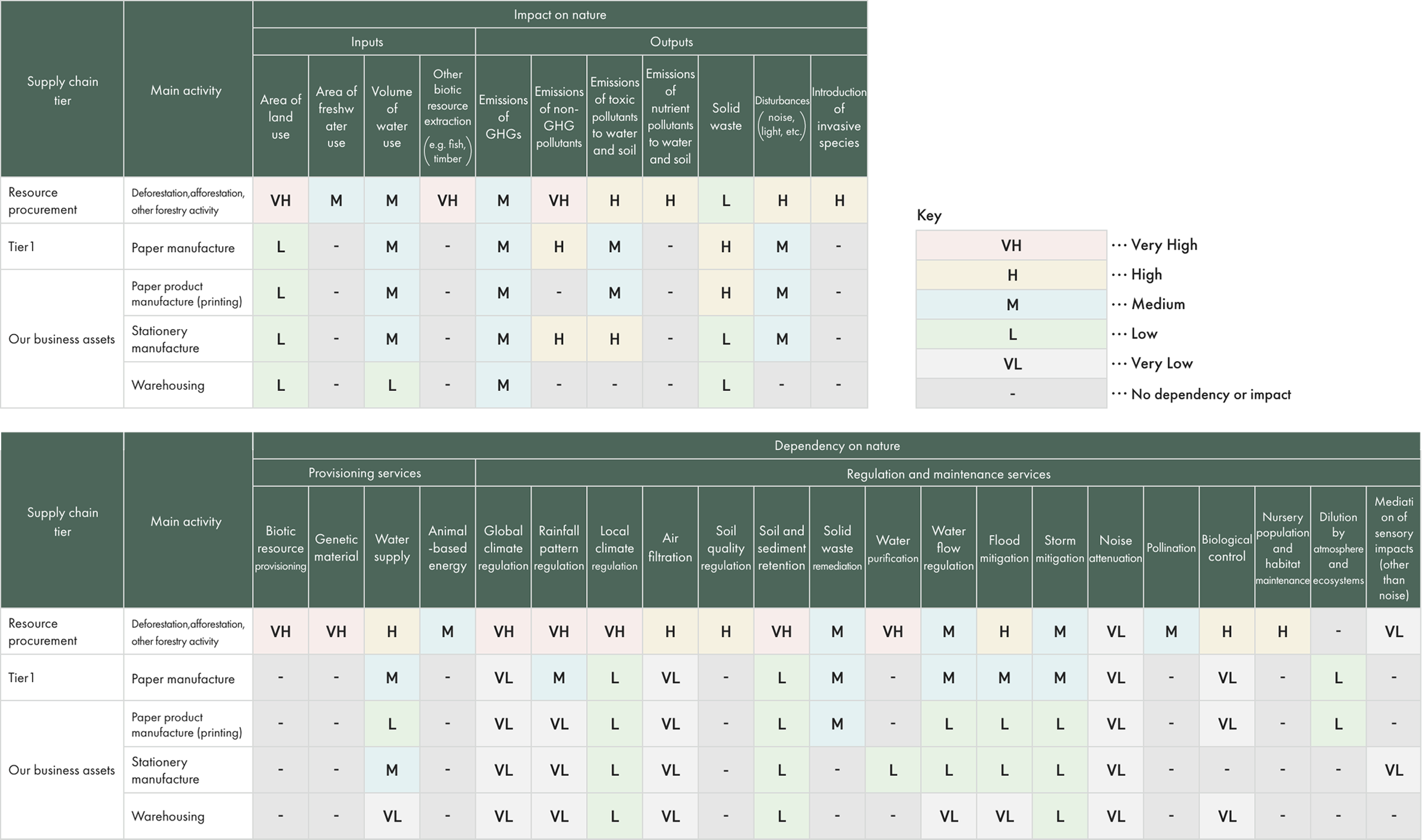

The ENCORE analyses of production assets in the stationery business have highlighted environmental impacts such as air pollution, waste, and water use. However, all these concerns pertain to emissions from pulping processes, which has limited relevance to KOKUYO Group’s actual business activities. Among the operations in the stationery business, production of paper products (such as notebooks) involves procuring semi-finished paper products (products already processed from pulp) and processing them into finished products (mainly by printing). As such, the main inputs are limited to use of general water and energy infrastructure. Both use of water and emissions of toxic pollutants to water and atmospheric emissions are low compared to the typical business sector values provided by ENCORE. Taking this into account, we assumed that if there is an interface of concern in KOKUYO Group’s production of paper products, then it is the environmental impact of the handling and disposal of waste. It is also true that assessments of plants producing glue tape and drawing and painting equipment indicate high dependencies and impacts in atmospheric pollution, emission of toxic pollutants to water, and use of water. Taking this into account, and considering also the use of chemical substances in production, we recognized this as a dependency and impact of concern.
Analysis of supply channels for paper (as a raw material) indicate a very high level of environmental impact associated with production activities involving forest resources (tree felling, afforestation) and a very high level of dependency of such activities on ecosystem services. These findings are consistent with our own view of the situation.
Pulping is, as mentioned above, something that takes place in our upstream supply chain. We therefore recognize as a concern environmental impacts of paper production such as atmospheric pollution, emission of toxic pollutants to water, and use of water.
2.Understanding our Relation to Sensitive Locations
The TNFD advocates four criteria for recognizing sensitive locations: biodiversity importance, ecosystem integrity, water risk, and cultural importance of ecosystem service. Using this set of criteria, we investigated where our businesses interface with IUCN protected area categories and KBAs, the levels of flood risk and water stress, and the level of alteration to the natural environment, with reference to external mapping analysis tool.
The results are shown below. For each location, the analysis covered the area within a 1 km radius of the center of the asset location.
Table 3. Business assets in sensitive locations
| Company | Facility name | Importance to biodiversity | Water risk* | |||
|---|---|---|---|---|---|---|
| Designated protected area | IUCN protected area category |
Proximity | Water stress | Flood risk | ||
| KOKUYO Product Shiga Co., Ltd. | Headquarters Plant | Koto Prefectural Natural Park | V | Within 1km radius | Low - Medium | Low - Medium |
| KOKUYO MVP Co., Ltd. | Tottori Plant | Lake Koyamaike wildlife sanctuary | IV | Within 1km radius | Low - Medium | Low - Medium |
| Aoya Plant | Nishi-Inba Prefectural Natural Park, common fishery right area (Tottori) | V,VI | Within 1km radius | Low - Medium | Low - Medium | |
| KOKUYO Supply Logistics Co., Ltd. | Shutoken IDC | Tokyo Bay wildlife sanctuary | IV | Inside designated area | Low - Medium | Low - Medium |
| Shiga NDC | Koto Prefectural Natural Park | V | Within 1km radius | Low - Medium | Low - Medium | |
| KOKUYO-IK (THAILAND) CO., LTD. | Thailand Plant | - | - | - | High | Extremely High |
| KOKUYO Commerce (Shanghai) Co., Ltd. | Shanghai Plant | - | - | - | Extremely High | High |

-
*Water risk assessment utilizing World Resources Institute Aqueduct Water Risk Atlas framework indicators.
2.1 KOKUYO Group Business Assets
The assets in KOKUYO Group’s stationery business mainly comprise plants and distribution centers. In plants, the main operations are printing and stationery production. At the plants in Japan and the plant in Shanghai, namely KOKUYO Commerce (Shanghai) Co., Ltd., paper goods are processed. Overseas plants other than the one in Shanghai produce writing tools, crayons, glue tape, and correction tape.
The results indicated that two plants used for processing paper products (KOKUYO Product Shiga and KOKUYO MVP’s Tottori Plant ) and one distribution center in the Tokyo metropolitan area (KOKUYO Supply Logistics) are located in or near a wildlife sanctuary. Another finding was that plant used for processing paper products (KOKUYO MVP’s Aoya Plant) is located near the coastline of the Sea of Japan and the vicinity lies within a common fishery right area and a prefectural natural park. However, these assets have a limited impact on protected ecosystems, in that they emit no or only limited toxic substances into the air or water and because one of the assets has measures in place to protect birds.
As for overseas assets, an Aqueduct analysis of water risks indicated highly concerning flood and water risks in the Shanghai plant (used for processing paper products) and in the KOKUYO-IK’s plant (Thailand), which produces clear books, PP file folders, glue tape, and correction tape. KOKUYO-IK, in its use of water, was revealed to be discharging toxic substances into the water. We concluded that this asset requires attention.
We also analyzed water risks in the 1 km radius around KOKUYO Camlin (India), which produces crayons and art equipment. The analysis indicated that such risks are lower than those pertaining to the Thai and Shanghai plants. However, the broader geographic context raises some concerns. The asset is located in the Maharashtra, which is prone to droughts. The drought risk in turn creates a risk of water restrictions being imposed in downstream areas. Taking this factor into consideration, we concluded that risk is similar to that in the Thai and Shanghai locations.
2.2 Areas Where Tier-1 Suppliers Operate
For its paper-related products, KOKUYO Group entrusts pulping to major suppliers; as such, the upstream supply chain is likely to be heavily dependent upon water resources. The major suppliers with whom we deal directly are located in Japan and Indonesia. We conducted an Aqueduct analysis in sensitive locations in Japan and Indonesia, revealing a high level of water stress and flood risk in the Indonesian locations.
2.3 Analysis of Forest Resource Procurement Areas
Timber resources are the most important of the natural resource to KOKUYO Group’s businesses. We need to observe socioenvironmental developments affecting forest plantations and communities where forest workers are active, as such developments constitute one of the most critical variables in whether we can continue to use paper as resource for our products. We are working to establish traceability in our timber procurement so that we can be assured that the resources we procure were produced in sustainable and sound ways. When assessing the dependencies and impacts of the sites from which we procure forest resources, we apply our Sustainable Procurement Policy alongside the LEAP approach.
The raw materials used to make the paper products that we trade in the stationery business are mainly derived from broad-leaved pulpwood. However, woodchips prepared for pulping are an assortment sourced from forests in multiple locations, making it unfeasible to distinguish the breakdown by procurement source. Accordingly, we have created a rough breakdown derived in part from qualitative information gleaned from interviews with major paper suppliers. The main procurement locations for paper are shown in Figure 2.
Figure 2. Map of locations from which woodchips are sourced
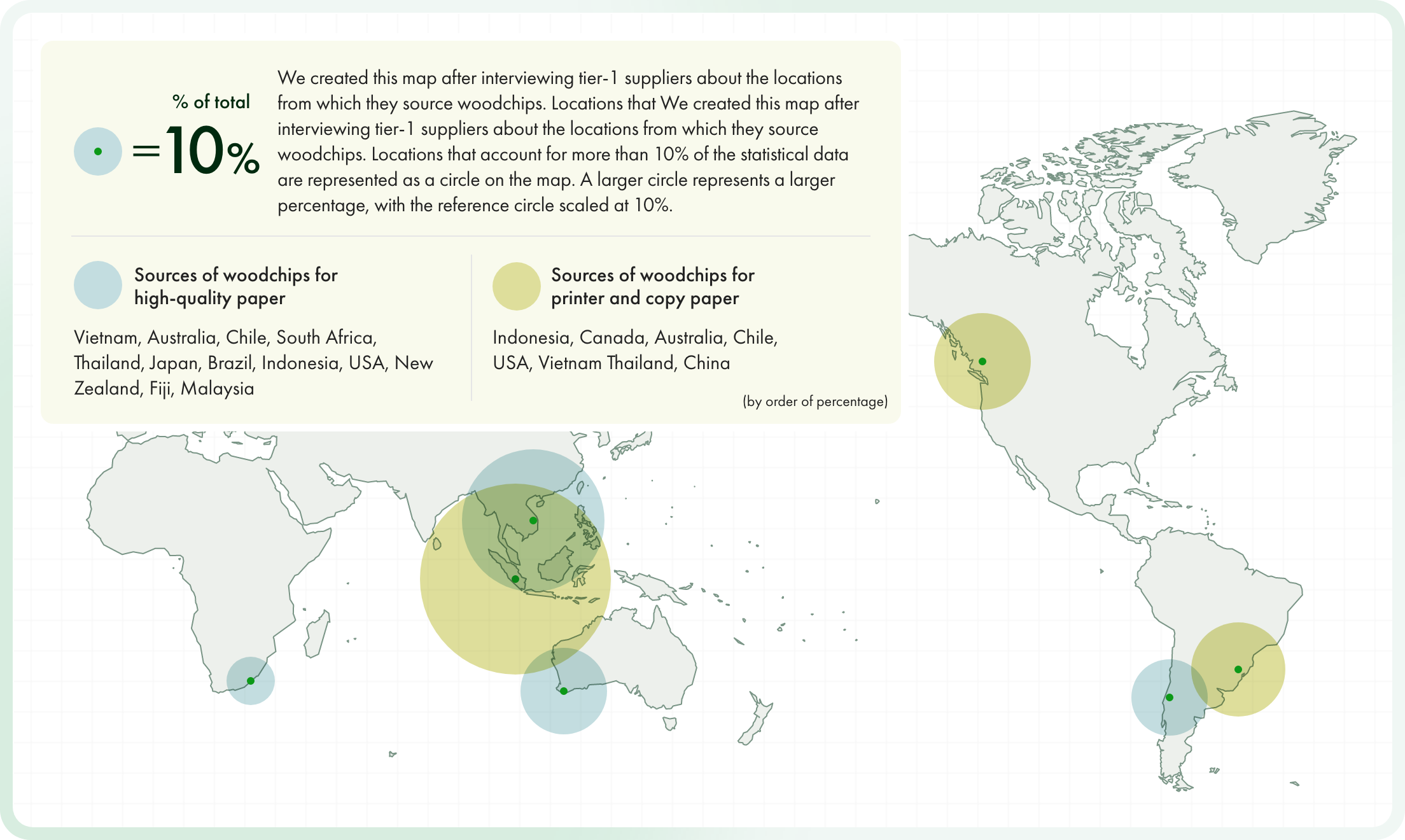

-
*The above figures do not represent actual values; they represent estimates gleaned from interviews with tier-1 suppliers and from publicly available information. Because the woodchips are all pulped together, regardless of where they came from, it is unfeasible to determine the exact breakdown. The above data may therefore differ from the reality.
The above results show that the procurement of forest resources used in our paper products is concentrated in Southeast Asia (Vietnam and Indonesia) and that a fair proportion of the resources come from Australia, Chile, and South Africa. With this information, we used the WRI’s Global Forest Watch app to check the condition of the forests in these source areas. In Table 5, we have shown the tree cover loss we observed along with contextual information. Deforestation is most striking in the Southeast Asian locations, and it is driven by the conversion of woodland into commercial land and by forestry practices. The developed nations of Australia and Canada have committed to forest conservation, with regulations that limit the areas in which forestry can be practiced. However, global warming has increased the prevalence of forest fires, which could negatively impact the prospects for sustainably procuring the forest resources.
Table 4. Forest condition in assumed locations from which tier-1 suppliers procure woodchips
| Woodchip category | Source | % of total (estimate*1) |
Forest condition*2 |
|---|---|---|---|
| Woodchips for high-quality paper | Vietnam | c.30% |
National tree cover loss since 2000: 3.56 Mha Main drivers of tree cover loss: Land conversion, forestry Government encourages acacia cultivation |
| Australia | c.18% |
National tree cover loss since 2000: 9.03 Mha Main drivers of tree cover loss: Forest fires, forestry National and provincial governments regulate forestry to conserve forests |
|
| South Africa | c.16% |
National tree cover loss since 2000: 1.60 Mha Main drivers of tree cover loss: Forestry Government has banned logging and land conversion in primary forests |
|
| Chile | c.10% |
National tree cover loss since 2000: 2.35 Mha Main drivers of tree cover loss: Forestry National Forestry Corporation manages forestry practices properly |
|
| Woodchips for printer and copy paper | Indonesia | Large share |
National tree cover loss since 2000: 30.8 Mha Main drivers of tree cover loss: Logging Conflicts arise between loggers and indigenous communities over rights to the land |
| Brazil | Medium share |
National tree cover loss since 2000: 68.9 Mha Main drivers of tree cover loss: Logging The government supports land conversion in anticipation of rising global food demand |
|
| Canada | Medium share |
National tree cover loss since 2000: 57.5 Mha Main drivers of tree cover loss: Forest fires Logging is regulated at a national level, with loggers required to plant at least as much trees as they fell |

-
*1These percentages do not represent actual values; they represent estimates gleaned from interviews with tier-1 suppliers.
-
*2The tree cover loss figures were obtained from desk-based research using Global Forest Watch. They were compiled according to the Global Forest Watch data as of February 2025.
3. Risks and Opportunities
Our assessment of the nature-related risks and opportunities in the KOKUYO group value chain is based on the main dependencies and impacts we have identified and the outcomes of our research into forest conditions in nearby sensitive locations and resource procurement locations. We thereby identify and evaluate both the risks to our group value chain and the impacts our group business and actions have on the environment and society (double materiality).
When identifying the relevant risks and opportunities, we use the relevant risk and opportunity categories in the TNFD risk and opportunity registers and the TNFD sector-specific guidance. When analyzing how the risks and opportunities affect KOKUYO Group, we use the scenario analysis outlined in the TNFD’s guidance on scenario analysis.
When evaluating the materiality of each risk, we take into account the materiality of the dependencies and impacts and the scale of the inputs and outputs, using the region-specific risk indicators set out in the WWF Risk Filter Suite.
The TNFD guidance on scenario analysis recommends using exploratory scenarios to describe uncertainties and plausible futures, taking into account the characteristics of the region and asset as well as factors that are of significance to the business model.
In accordance with this approach, the scenario analysis we conducted in fiscal 2024 first clarified what form the risks and opportunities for the business facilities and regions we see as particularly important to our operations are likely to take. This is based on an assessment of our dependencies and impacts and a survey of sensitive locations. It then examined the potential financial impacts for the KOKUYO group and how likely they are to materialize.
Following the example approach set out in the TNFD guidance for scenario analysis, we adopted two critical uncertainties, each with two possible states. The first was ecosystem service degradation, which describes the extent of the physical impact (moderate or severe). The second was alignment of market and non-market driving forces, which describes the extent to which driving forces are transitioning to nature-positive actions (transition risk: high or low). We combined these two critical uncertainties to create a 2×2 matrix with four scenarios for consideration. We then plotted onto this matrix the key assets and regions relevant to the value chain of our stationery business. We then analyzed the interactions between them and identified the four plausible future scenarios shown in Figure 3.
Figure 3. Plausible future scenarios
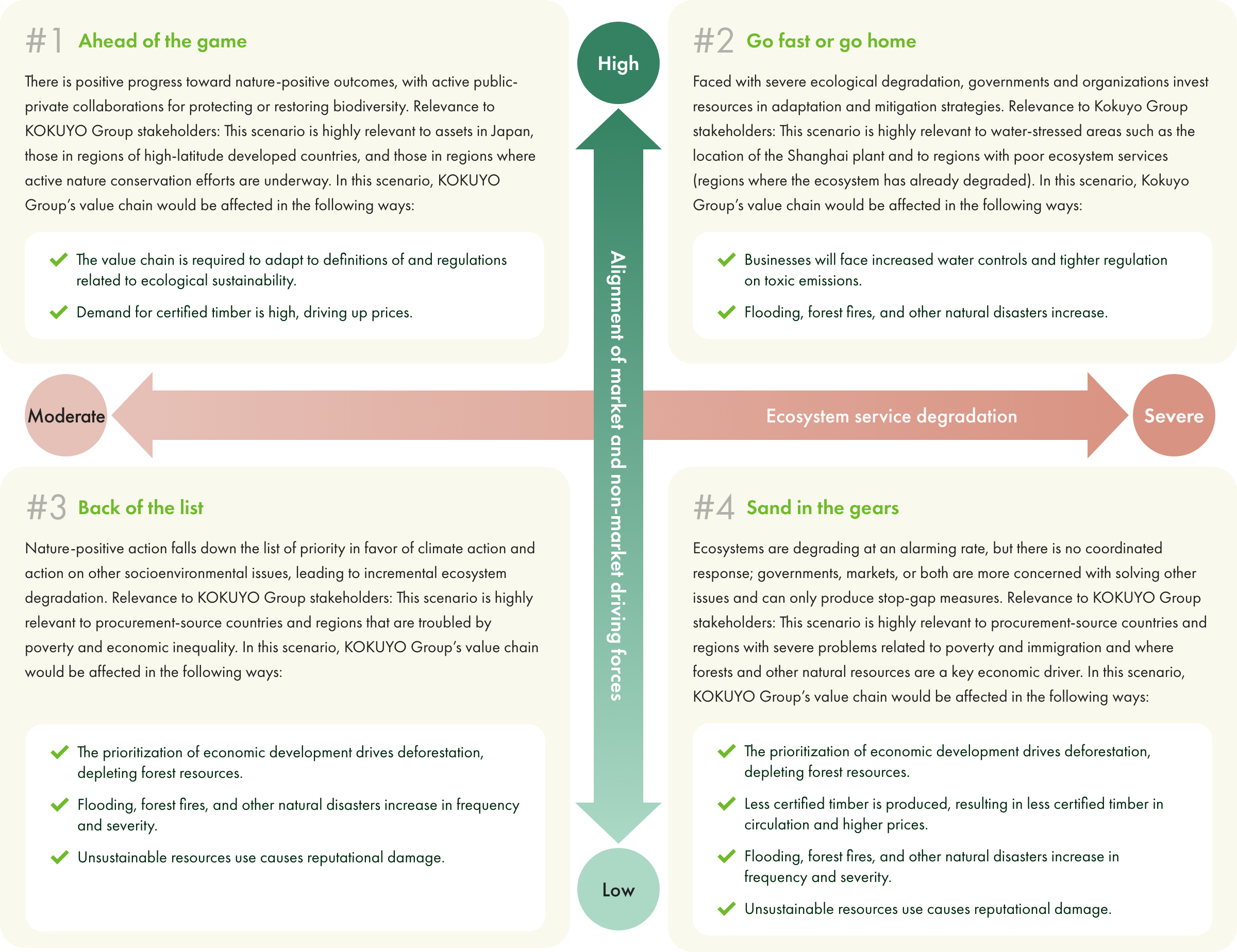

4. Scenario Analysis
Table 5 summarizes the risks and opportunities we think are key issues for the KOKUYO group’s Stationery Businesses as a result of this analysis.
“Impact” describes the potential social and environmental impacts of KOKUYO Group’s activities. “Risks” and “opportunities” describe the financial impacts on KOKUYO Group. “Severity” takes into account the score for the relevant risk item in the WWF Risk Filter Suite, the scale of the KOKUYO Group activities concerned, and the risk probability according to the scenario analysis.
Table 5. Risk and opportunity evaluation outcomes
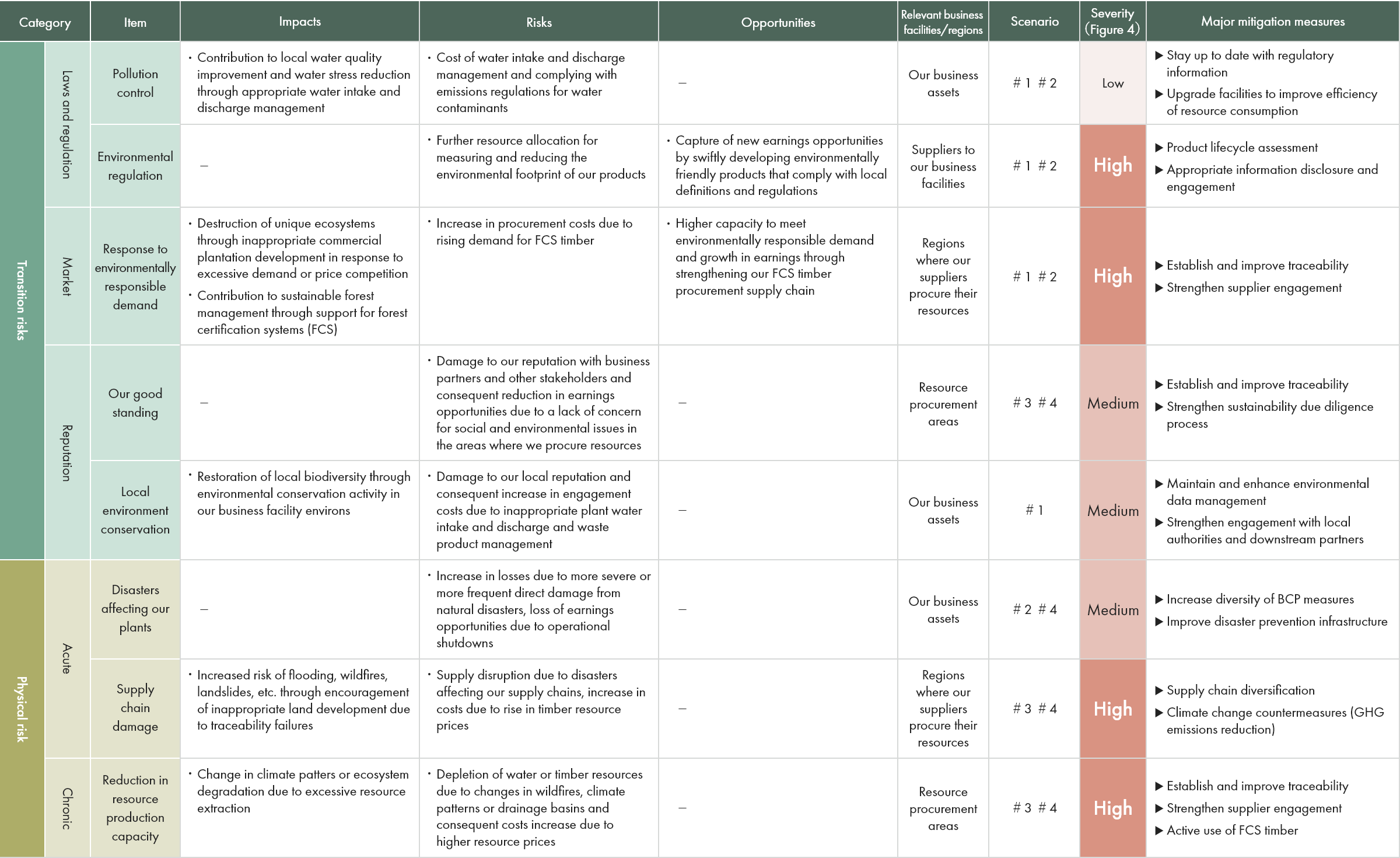

5. Current Actions to Address the Issues
We are addressing the key issues identified in the analysis by promoting sustainable procurement across KOKUYO Group. To that end, we established the KOKUYO Group Policy on Timber Procurement in 2011 and the KOKUYO Group Standards for Paper and Timber Procurement in 2024. We have also started engaging with stakeholders across our supply chain. In the stationery business, we promote sustainable use of forest resources. The Forest Stewardship Council (FSC) has certified our printer and copy paper and notebooks.
We also support community action. In 2006, we launched a project to conserve a private forest in the Taisho district of Shimanto, Kochi Prefecture. In this project, we thin the forest and make effective use of the resulting timber. In 2007, the project was certified by the FSC. KOKUYO Product Shiga participates in a project to conserve the reedbeds in Biwa Lake in line with Shiga Prefecture’s ordinance on reedbed protection. The project involves protecting the reedbeds and promoting their sustainable use in order to preserve Lake Biwa’s environment.
Learn more about these initiatives on the following pages: Implementing the basic policy, Yui-no-Mori Project, and ReEDEN Project (FSC® C004748).
6. Future Actions
The LEAP-based analysis revealed concerns regarding the procurement of woodchips used for our paper products. These findings remind us of the need to engage with stakeholders at the various stages of timber resource procurement. Of particular concern is the risk that procurement activities in Vietnam, Indonesia, and other parts of Southeast Asia could be abetting deforestation. The findings also give us the hope that, with effective communication, we can promote sustainable use of forest resources and make our supply chain more resilient. We have therefore concluded that we should develop robust due-diligence processes for the regions identified as high-priority regions.
The LEAP analysis we conducted in 2024 was limited to the stationery business. We will conduct a similar analysis in the furniture businesses and other businesses to increase the quality of our disclosures. See here for information about use of forest resources in the furniture business.
Risks and Impacts Management
Our Environment Subcommittee (a subcommittee of the Sustainability Committee) identifies and evaluates our dependencies and impacts on nature and our nature-related risks and opportunities with the participation of managers responsible for each business division. This is guided by the findings of regular internal and third-party research.
This regular research identifies and evaluates matters based on the findings of LEAP-based research and analysis in response to issues and requests raised by our governance and due diligence processes. We have evaluated the identified nature-related issues by severity and frequency, taking into account the importance of each risk and opportunity as shown in Table 5. The severity score takes into account a range of factors, including the scale of the business activities in KOKUYO Group and its supply chain (the scale of procurement, monetary amount of procurement, amount of natural resources used) and the output results of external evaluative tools related to nature. The frequency score is the result of a qualitative analysis that includes the scenario analysis and takes into account the relevant KOKUYO Group business activities and local factors (regulatory landscape, market trends). Items that scored high in both indicators were defined as high-priority items.
Once the risks are identified and evaluated, they are communicated to the business divisions concerned. The strategic implications of the risks are incorporated into strategic planning by the Environment Subcommittee, while business-specific implications are addressed by the relevant business divisions. For groupwide risk management, the Risk Management Committee has been organized to steer efforts across the corporate group.
To integrate nature-related risk management into this existing system for groupwide risk management, the Risk Management Committee will now coordinate with the Environment Subcommittee. The Environment Subcommittee provides the Risk Management Committee with reports about important risk-management matters and the state of compliance with environmental laws and regulations.
Table 4. Schema for assessing risks and opportunities
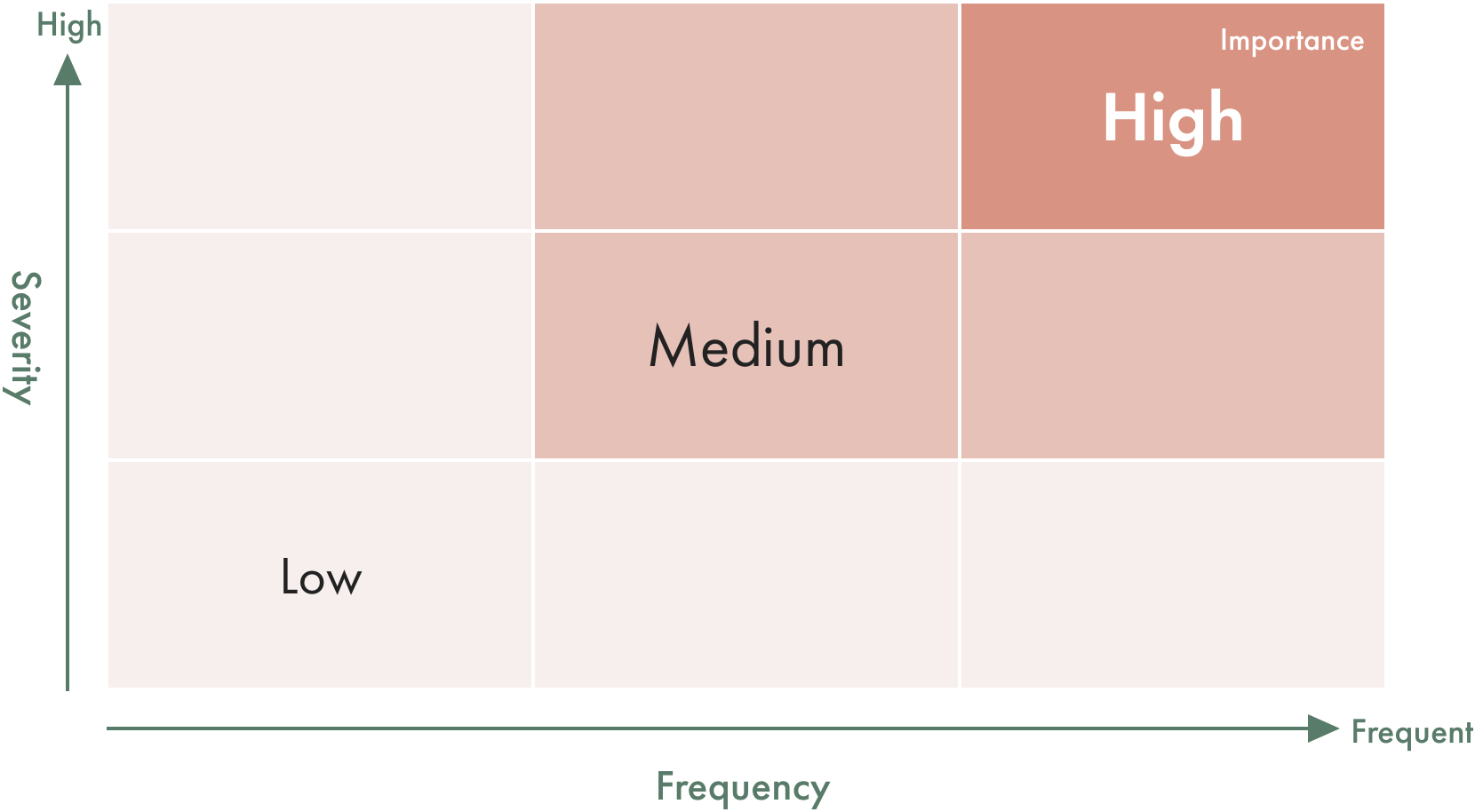
Metrics and Goals
Table 6 shows the KPIs for tracking the progress of our efforts to address our fifth material issue: contribute toward a society that coexists with nature.
Table 6. Contribute toward a society that coexists with nature (material issue)
| 2030 challenge goals | 2027 commitment goal | Main actions (taken in FY2024) |
|---|---|---|
| Carbon footprint of business activities visualized and carbon neutrality achieved |
|
|
| Forest conservation: Forests thinned at about 150 hectares a year |
|
|
| Reedbed conservation: Reeds trimmed at about 1.5 hectares a year |

Every year, we upload to the ESG databank section of our website about our use of natural resources, emissions of toxic substances, and other disclosures. Table 7 lists nature-related metrics (identified in the LEAP analysis) for the disclosure indicators set out in the TNFD guidance, along with links to the relevant ESG disclosures.
Table 7. Related indicators
| Metric No. | Nature-related variable | Indicator | Where data is disclosed |
|---|---|---|---|
| C1.0 | Total spatial footprint | Total surface area where the organization has control |
ESG Databank>Reports on Business Sites in Japan ESG Databank>Reports on Business Sites Overseas |
| C2.0 | Pollutants released to soil | Amount of pollutants released to soil | N/A (no such pollutants) |
| C2.1 | Wastewater discharged | Volume discharged | ESG Databank>Water Resource Saving |
| Volume of toxic substances in discharged wastewater |
ESG Databank>Chemical Substances Subject to PRTR Law ESG Databank>Environmental Load Material Flow |
||
| C2.2 | Waste generation and disposal | Weight of total waste | ESG Databank>Resource Saving and Recycling |
| Weight of hazardous waste | |||
| Volume of waste recycled | |||
| C2.3 | Plastic pollution | Weight of plastic used | ESG Databank>Resource Saving and Recycling |
| C2.4 | Air pollutants | Non-GHG air pollutants weight by type |
ESG Databank>JEPIX ESG Databank>Chemical Substances Subject to PRTR Law ESG Databank>Environmental Load Material Flow |
| C3.0 | Water withdrawal and consumption from areas of water scarcity |
Amount of water withdrawal and amount of consumption from areas of water scarcity |
ESG Databank>Reports on Business Sites Overseas>Thai Plant ESG Databank>Reports on Business Sites Overseas>Shanghai Plant |
| C3.1 | Quantity of high-risk natural commodities sourced from land/ocean/freshwater |
Quantity of timber sourced |
ESG Databank>Using Less Forestry Resources
|
| C7.0 | Risks | Value of assets, liabilities, revenues, and expenses that are assessed as vulnerable to nature-related transition risks | To be disclosed in future |
| C7.1 | Value of assets, liabilities, revenue, and expenses that are assessed as vulnerable to nature-related physical risks | ||
| C7.2 | Description and value of significant fines/penalties received, or litigation action, in the reporting year covered by nature-related disclosure due to negative nature-related impacts | ESG Databank>Environmental Accounting | |
| C7.3 | Opportunities | Amount of capital expenditure, financing, or investment deployed towards nature-related opportunities | |
| C7.4 | Increase and proportion of revenue from products and services producing demonstrable positive impacts on nature |
